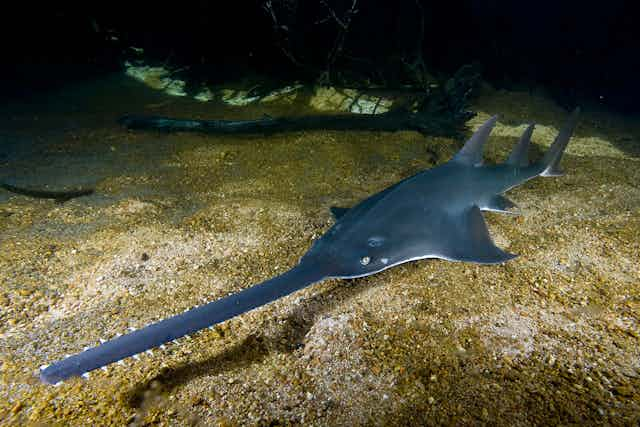Sawfish are the most endangered group of marine fish in the world, largely thanks to overfishing and habitat loss. Formerly abundant, they have disappeared from many countries’ waters, and in many others they are scarcely holding on.
To put it bluntly, sawfish have been devastated. But we could reverse the trend. Recently the International Union for Conservation of Nature’s Shark Specialist Group released the first Global Sawfish Conservation Strategy. It won’t be easy, but they are steps we need to take if we are to save the world’s threatened sawfish.
Tall tales

There are five species of sawfish — all large, iconic, tropical and subtropical fish closely related to sharks.
These are the world’s largest rays, with one species growing to reach 7 metres in length. Even the smallest species, the Dwarf, reaches over 3 metres.
They are a charismatic group of fish, with various legends attached (all can be found in the sawfish strategy). Sawfish body parts have been hung over doorways to keep ghosts out. Muslim teachers rode on their backs performing miracles.
In the 16th century one saved a vessel by plugging a hole in its hull. Dozens of the animals are interred beneath the Aztec Great Temple of Mexico City. And sawfish have been used to make cowboy boots, fence posts, weapons, and to cure diarrhoea.

History of decline
All five species are now classed as Endangered or Critically Endangered. Of the 92 countries where they used to be found, 43 countries have lost at least one species, and sawfish are completely extinct from 20 countries.
While they have declined in area, there is hope that sawfish will persist in more remote regions such as Northern Australia, which is home to relatively healthy populations of four species.
Like many threatened marine animals we can point to overexploitation and habitat loss. The long toothed rostrum of sawfishes is easily entangled in nets.
Their fins, rostra (the sawfish’s “saw”), meat and other body parts can fetch a fair price, in fact their fins are amongst the most preferred in the Asian shark fin soup market, and can fetch up to US$4,000 a set. These are arguably some of the most valuable marine products in trade. This has helped drive sawfish retention when they have been caught as bycatch in fisheries.

They live in shallow, inshore, coastal and riverine waters, and these habitats overlap with intense fisheries and habitat modification.
In many tropical parts of the world these activities are unregulated and unmanaged. Throw in their biological traits – like many sharks and rays, sawfishes have low productivity – and they do not have the capacity to sustain high levels of exploitation or to recover from that without serious conservation action.
Five steps to sawfish recovery
If we want to recover sawfish populations, then we are going to have to get serious.
Like many conservation programs, it will require a combination of actions. But many of these actions are the kinds of things that would improve fisheries sustainability and the conservation of a wide range of large coastal wildlife such as sawfish anyway. Minimising the threats of habitat loss and overfishing is the key.
Here are five steps we should take to protect sawfish.
First, international conservation agreements. With sawfish ranging across nearly 100 countries, there will need to be action at international and regional levels, not only at national levels. The listing of sawfishes on the Convention on International Trade in Endangered Species, following Australia’s proposal, is a great step. Protection on other international conventions, such as the Convention on Migratory Species, is an obvious next step.
Second, legal protection of sawfishes in key range states. Sawfish are currently only protected in 16 countries. Sawfish need protection in a number of priority countries including Papua New Guinea, Pakistan, Tanzania, Guinea, Venezuela and Cuba. These are countries where sawfish are barely holding on, or may persist in remote areas.

Third, community engagement and outreach. We hear this a lot in conservation, but only by engaging with local communities on the ground can effective change be made. We need to develop a community toolbox to raise awareness and help collect data. The toolbox might include: identification materials, safe handling and release guidelines, data collection guidance, and ways to reduce bycatch. There is great work already happening in places like West Africa but more is needed.
Fourth, enforcement. Sawfish countries will need to strictly enforce fisheries management and international and national conservation regulations. Enforcement starts with good training to provide enforcement and customs officers with the skills they will require which includes species identification.
Finally, fundraising. This may indeed be one of the greatest challenges. But the development of a network of nearly 150 sawfish experts has made great headway in raising sufficient awareness and local funding.
Sawfish can be saved. The progress made in Australia and the USA shows that sawfish populations can be protected and populations may even be recovered.
Through these simple and proven actions we have the power to save these most imperilled and iconic marine fishes.

